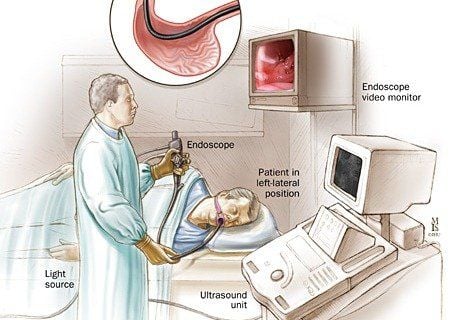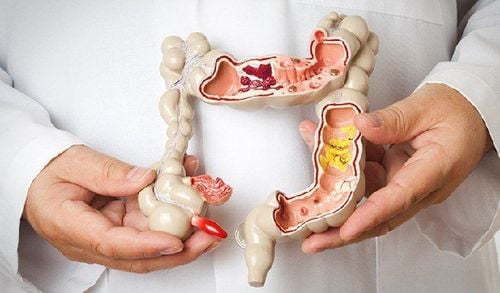This is an automatically translated article.
The article is professionally consulted by Master, Doctor Mai Vien Phuong - Gastroenterologist - Department of Medical Examination & Internal Medicine - Vinmec Central Park International General Hospital.Painless gastrointestinal endoscopy is one of the most advanced methods today to examine and detect signs of damage in the gastrointestinal tract. The technique is performed in a short time, the patient is comfortable and there is no pain, vomiting.
1. Anesthesia gastrointestinal endoscopy method
Painless gastrointestinal endoscopy, also known as anesthesia endoscopy, means that you will be sedated before the procedure so that you do not feel pain or discomfort like a traditional technique.
Hình ảnh nội soi tiêu hóa được thực hiện tại Bệnh viện Đa khoa Quốc tế Vinmec
No pain or discomfort discomfort, nausea, fear during endoscopy and phobias after endoscopy. Safe because the anesthetic time is short, the amount of anesthetic is low, so it does not affect health. You will be awake as soon as the endoscopy procedure, without affecting the nervous system or health. Clear, detailed and accurate observation images are good support for doctors in the process of examination, biopsy and diagnosis of medical conditions. No damage to the gastric mucosa because the patient lies still, easy to perform precise manipulation. Quick implementation (5–15 minutes), shortening time compared to traditional methods.
2. Notes when performing endoscopic anesthesia
However, before performing endoscopic anesthesia, you need to note a few points:
It is necessary to inform the doctor about any drugs, herbs or supplements you are taking such as: diabetes drugs, drugs prevent coagulation prior to endoscopic anesthesia. You fast for at least 6 hours, do not drink carbonated drinks or coffee or milk... Especially with endoscopy, stop drinking water about 2-3 hours before the endoscopy to avoid reflux into the lungs. . It is necessary to test with anesthetics first to avoid drug side effects. After endoscopic anesthesia, do not spit, eat and drink within 30 minutes. After endoscopic anesthesia, if you detect abnormal symptoms such as severe abdominal pain, chest pain, dark stools, prolonged vomiting, difficulty breathing, high fever, etc., you should immediately notify your doctor for treatment. timely handling. The thing to pay attention to after the endoscopy is that the patient should not drive himself, or make important decisions on the day of the colonoscopy, because during the endoscopy, anesthetic drugs are used, which can make people uncomfortable. the patient is not alert when driving or making decisions.
3. Nasal endoscopic method
Nasal endoscopy is a method of endoscopic upper gastrointestinal tract through the nose, the endoscope is equipped with a very small, inserted through the nostrils, down the throat and down the digestive tract without going through the mouth. Therefore, do not touch the roof of the palate, the uvula, so there is absolutely no feeling of nausea, vomiting or irritation, you are still awake and can talk to the doctor.
Nội soi tiêu hóa không đau giúp bệnh nhân thoải mái và không bị đau, nôn ói
Performing nasal endoscopy brings many benefits to the patient. Specifically as follows:
Minimize discomfort: Does not cause nausea, vomiting, discomfort, .. like when endoscopy through the mouth. Can communicate: You can communicate with the doctor during the endoscopy High efficiency: The small endoscope can go through the lesions that cause narrowing of the digestive tract and have the ability to explore more deeply, in more detail in places where conventional endoscopes cannot pass. Safety: This painless gastrointestinal endoscopy does not require the use of anesthesia and causes little change in blood pressure or heart rate. Therefore, it is beneficial for those who suffer from cardiovascular diseases, blood pressure,... Quick: Nasal endoscopy has a very fast preparation and endoscopy time, only takes about 15 minutes. The doctor has time to carefully examine and fully evaluate the lesions, including early gastric cancer lesions. It is still possible to do cytological tests, look for H.pylori bacteria and hemostasis procedures, polyp removal,... However, this method is contraindicated in cases where people have narrowing of the nasal passages and deformities. Nasal septum is not possible.
4. Gastrointestinal endoscopic method through capsules
Capsule endoscopy is when you swallow a camera device shaped like a marble pill. This device can continuously capture 3 images in 1 second and transmit it to the monitor next to the tester.
The time this special capsule goes from the mouth to the anus will take about 8-10 hours. During this time, the patient can still do normal activities and do light work. Capsules will be excreted in the faeces after defecation.
All images during those hours will be saved on the computer for the doctor to review and diagnose if any. Thus, a painless gastrointestinal endoscopy with capsules takes a total of 10 to 12 hours.
Advantages of capsule endoscopy
This is a painless gastrointestinal endoscopy method that does not cause shortness of breath and vomiting like conventional endoscopy methods through the tube. Images can be visualized in the intestinal tract, small intestine, large intestine, duodenum, areas that are difficult to reach with conventional endoscopy. There is no need for anesthesia or sedation during the procedure and the examiner can eat, drink and work normally. Eliminate the risk of infection with HP virus through shared endoscopes. Absolutely no side effects or complications such as ulcers in the stomach that get worse after endoscopy (common with rigid tube endoscopy). However, when capsule endoscopy reveals a suspected lesion, gastrointestinal endoscopy with a flexible endoscope still needs to be performed, in order to better evaluate the lesion, direct tissue sampling for the purpose of histopathological investigation.
Currently, Vinmec Central Park International General Hospital is applying many modern anesthetic endoscopic methods to help screen and screen for digestive cancer early.
To register for examination and treatment at Central Park International General Hospital, please contact Hotline: 0283 6221 166 or register online HERE.














